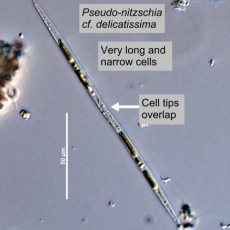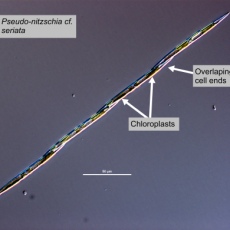
|

|
| P. delicatissima | P. seriata |
Classification
(Guiry and Guiry 2012)
Lifestyle
Description
Fusiform
Torpedo-shaped. Shaped like a small boat when viewed from above.
fusiform, united in stepped chains with overlapping valve ends. Chains are motile. Two plate-like chloroplasts are located along the CloseGirdle
In diatoms, the portion of the cell wall between the two valves of a cell; made up of intercalary bands (bands closest to the valves) and connecting bands (bands in the middle of the girdle). In dinoflagellates, the equivalent of a cingulum or transverse furrow (Horner 2002).
girdle, one on each side of the median transapical plane. Cells are yellow-brown in colour (Hasle and Syvertsen 1997).Striae
(referring to pores in diatoms) In diatoms, a striation or row of pores on the valve face. "In centric diatoms, striae may be radial, running from the centre of the valve to the margin ... In pennate diatoms, striae may be parallel to the median line of the valve or raphe" (Horner 2002).
striae, CloseInterstria
(plural: interstriae) The non-perforated siliceous strip between striae (Hasle and Syvertsen 1996).
interstriae). The CloseRaphe
"In some pennate diatoms, one or two longitudinal slits along the [long] axis or around the valve margins" (Horner 2002). Secretion of mucilage allows a pennate diatom to attach itself to or glide on a substrate (Regents of the University of California 2006).
raphe is off-center and not raised above the valve (Hasle and Syvertsen 1997).Measurements
Apical
(axis, spine) The region of the apex or point. Refers to the most anterior point or region of the cell (HPP 2003).
(apical axis): 25 - 160 μmWidth Close
Transapical axis
In diatoms, the longitudinal axis of the valve.
(transapical axis): 0.5 - 8 μm(Hasle and Syvertsen 1997)
Key to local species
Harmful effects
Habitat
Distribution
Environmental Ranges
Temperature range (°C): -2.045 - 29.468
Nitrate (μmol L-1): 0.030 - 34.037
Salinity: 17.940 - 38.049
Oxygen (mL L-1): 3.756 - 9.116
Phosphate (μmol L-1): 0.046 - 2.366
Close
Silicic acid
A general term to describe chemical compounds containing silicon, oxygen and hydrogen with a general formula of [SiOx(OH)4-2x]n. Diatoms polymerize silicic acid into biogenic silica to form their frustules (Azam and Chisholm 1976).
Silicate (μmol L-1): 0.648 - 116.089(OBIS 2012, cited in EOL 2012)
References
Encyclopedia of Life (EOL). 2012. Pseudo-nitzschia. http://eol.org/pages/13279/overview. Accessed 18 Feb 2012.
Fehling, J., Davidson, K., Bolch, C. J. and Bates, S. S. 2004. Growth and domoic acid production by Pseudo-nitzschia seriata (Bacillariophyceae) under phosphate and silicate limitation. Journal of Phycology. 40: 674-683.
Guiry, M. D. and Guiry, G. M. 2012. Pseudo-nitzschia H. Peragallo in H. & M. Peragallo, 1900: 263, 298. http://www.algaebase.org/search/genus/detail/?genus_id=44450. Accessed 18 Feb 2012.
Hasle, G. R. and Syvertsen, E. E. 1997. Marine diatoms. In: Tomas, C. R. (ed.) Identifying Marine Phytoplankton. Academic Press, Inc., San Diego. 5-385.
Kraberg, A., Baumann, M. and Durselen, C. D. 2010. Coastal Phytoplankton: Photo Guide for Northern European Seas. Verlag Dr. Friedrich Pfeil, Munchen, Germany. 204.
Ocean Biogeographic Information System (OBIS). 2012. Pseudo-nitzschia. http://www.iobis.org/mapper/?taxon_id=499390. Accessed 18 Feb 2012.
Howard, M. D. A., Cochlan, W. P., Ladizinsky, N. and Kudela, R. M. 2007. Nitrogenous preference of toxigenic Pseudo-nitzschia australis (Bacillariophyceae) from field and laboratory experiments. Harmful Algae. 6: 206-217.
